The Mountain West is nestled between the Front Range of Colorado and the east slope of California’s Sierra Nevada. It is home to one of earth’s most topographically elevated and biodiverse regions.
The Mountain West’s macroclimate is predominately continental – hot summers, cold winters, and little rainfall. Environmental factors such as land form, large bodies of water, cloud cover, or wind, further modify the predominate weather patterns to create localized microclimates. For example, the maritime microclimate of the Sierra Nevada is a consequence of its proximity to the moderating effects of the Pacific Ocean. The Intermontane Plateau, on the other hand, lies in the rain shadow created by the Sierra Nevada. The result is a drier, semiarid microclimate which extends from Reno to Salt Lake City. The role of elevation, as it relates to temperature regulation, is exemplified in the Rocky Mountains. Air masses moving over the Intermontane Plateau eventually collide with and are forcefully uplifted over the elevated peaks, resulting in adiabatic cooling and release of moisture. Because of this, the Rocky Mountain system enjoys a temperate microclimate that is cooler and wetter in comparison to the arid Intermontane Plateau. Another important aspect of the Mountain West’s macroclimate is that the majority of the precipitation is received during the winter months in the form of snow. This factor alone contributes greatly to the ephemeral nature of many early blooming plant species in the Mountain West.
So What Does Ephemeral Mean?
Ephemerality is derived from the Greek root word ephemeros, meaning literally to last for only one day. The term ephemeral is used quite often to describe objects found in nature, such as plants, which are transitory or exist for only a brief period of time. Many plants are adapted to an ephemeral lifecycle, in which they spend much of the year or longer as seeds, or even dormant during prolonged periods of drought, before conditions are right for an abbreviated period of rapid growth and reproduction. Early spring offers an excellent opportunity to see ephemeral Wildflowers of the Mountain West that are literally blooming one day and vanished the next. Spring ephemerals will often make their spring debut in the wake of retreating snowfields as the initial seasonal thaws make moisture available. The exposed ground warms quickly which further encourages plants out of dormancy.
Here are just a few examples of what you may find.
Fritillaria pudica
Fritillaria pudica, of the Liliaceae (Lily family), is a small perennial inhabitant of grassy knolls and sagebrush flats in the western United States (Idaho, Montana, Oregon, Washington, Wyoming, very northern California, Nevada, northwestern Colorado, North Dakota and Utah) and Canada (Alberta and British Columbia). It is amongst the first plants to appear in the moisture laden soils of receding snowfields. The bright yellow flowers age by turning brick-red in color. Of historical significance, Meriwether Lewis collected a specimen while passing through Idaho in 1806.
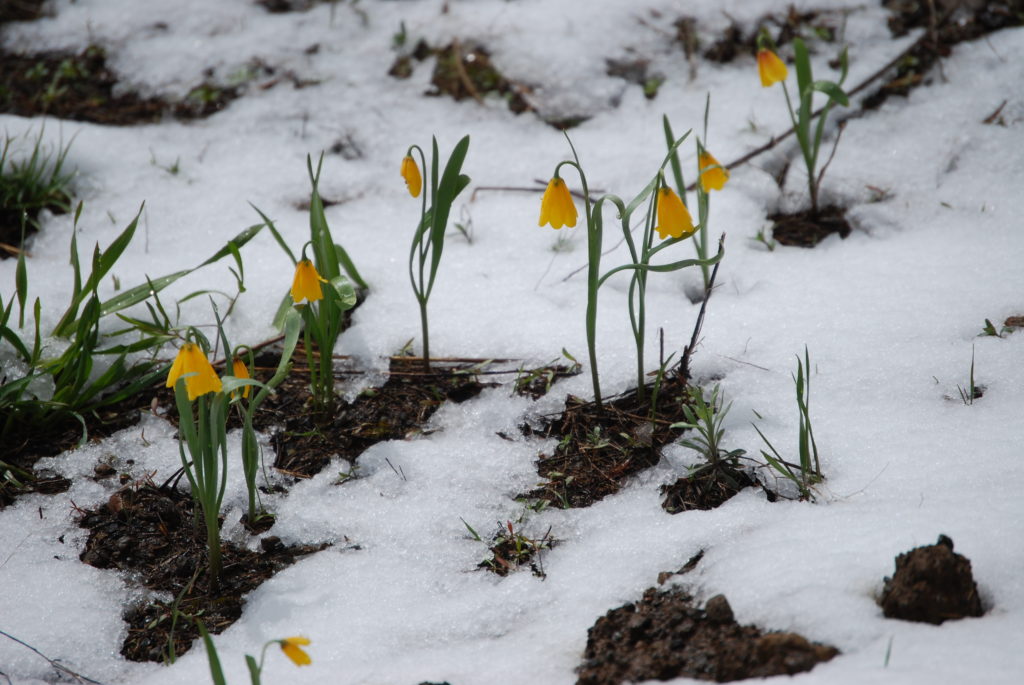
Erythronium grandiflorum
Along the banks of the Clearwater River, in present-day Idaho, Meriwether Lewis collected this plant for science in 1806. Eight years passed before a German botanist by the name of Frederick Pursh gave it a name and described its attributes. Erythronium grandiflorum is another spring ephemeral of the Liliaceae (Lily family) that makes its grand appearance in early spring. It is different than Fritillaria pudica in that it often appears in vast colonies, in subalpine meadows, slopes, and woodland fringes. Bees, especially bumblebees, are its primary pollinators. Erythronium grandiflorum grows from a bulb. The bulbs are an important and preferred food of the grizzly bear. Mule deer eat the foliage readily. It is native to western North America from British Columbia and Alberta south to northern New Mexico and northern California, distributed along the major north-south chains of the Northern and Central Rocky Mountain and Cascade ranges. Interestingly, it has not been documented from Arizona or Nevada. The Flora of North America recognizes two subspecies (subsp.), the yellow-flowered subsp. grandiflorum (as pictured) and the white- to cream-flowered subsp. candidum, which is a strictly limited to the Pacific Northwest.
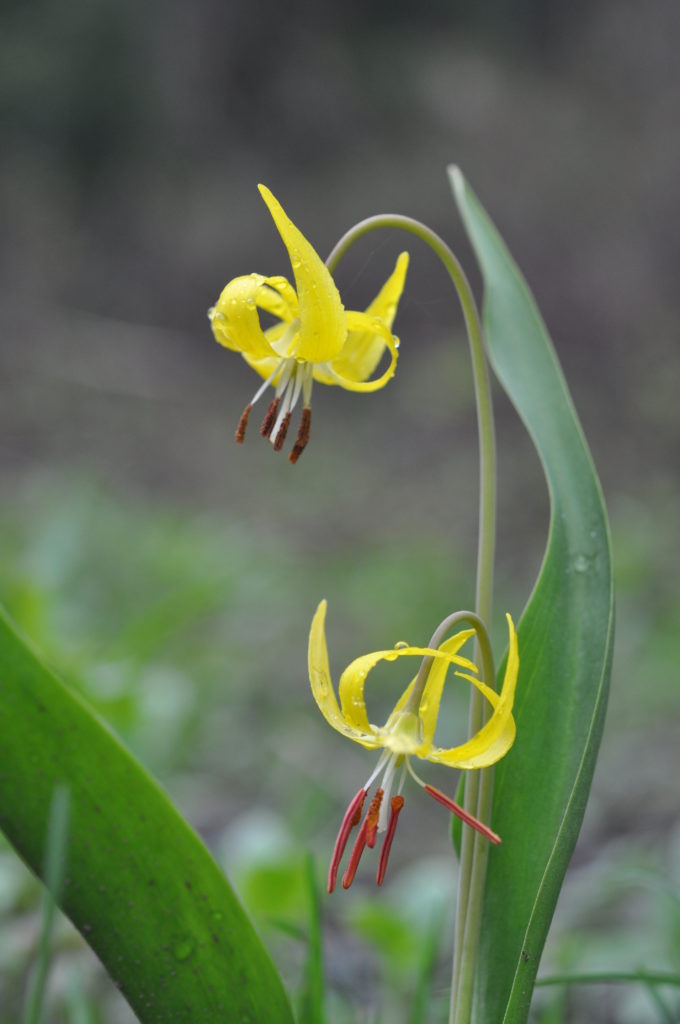
Dicentra uniflora
Steer’s Head is a small perennial member of the Papaveraceae (Poppy family). Authors Lynn and Jim Wilson, in their book Wildflowers of Yosemite, describe “the joy of seeing your first Steer’s Head” as one that “will never be forgotten, for it is truly a precious treasure to find.” The unique form of the Steer’s Head might suggest that it is a rare plant, however, its rarity is only because “it blooms only briefly just after the snow melts, so you have to be in the right place at the right time.” Steer’s Head is considered common in the nine western states (California, Colorado, Idaho, Montana, Nevada, Oregon, Utah, Wyoming, Washington) where it occurs. In Canada it is only found in extreme southern British Columbia. Very little is known about the basic biology and reproduction of Steer’s Head, however, bees appear to be the main pollinator. It is a host to the American Apollo butterfly (Parnassius clodius) and ants disperse its seeds. Dicentra uniflora will also reproduce vegetatively via bulbils, which are small bulb-like-structures that develop in the axil of a leaf or at the base of a stem. Steer’s Head typically grows from very early spring to late summer on rocky slopes and hillsides in gravelly soils near the edges of melting snowfields.
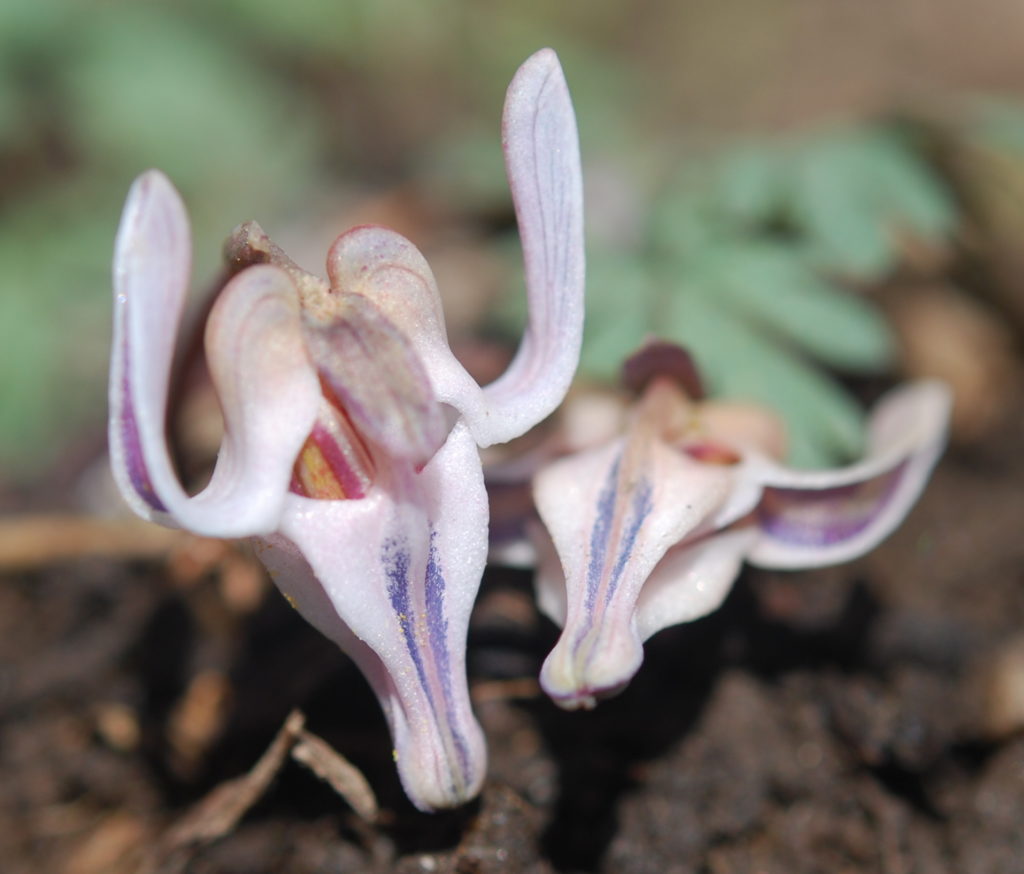
Olsynium douglasii var. inflatum
Olsynium is a genus of summer-dormant rhizomatous perennials in the Iridaceae (Iris family). Eleven members of the genus are found in South America, however, in western North America, from southern British Columbia, Canada, southward to northern Nevada and Utah, grows the dainty and beautiful Olsynium douglasii var. inflatum (Inflated grass widow). Inflated grass widow blooms from February to April along rocky bluffs and outcrops, in ponderosa pine woodlands and chaparral, lake margins, and on sunny, open slopes where it is moist in spring but dries out in the summer. It features clumping, grass-like leaves and stems that grow nearly a foot tall. Each flower has six purple to pink petals, sometimes white, that are sure to catch your eye. It is a fantastic plant for the rock garden and bees will gravitate to it during the early spring when floral resources are limited. The Flora of North America recognizes two varieties (var.), var. douglasii, which follows the Cascade Range in Oregon and Washington, and var. inflatum (as pictured) which is more inland (Columbia Plateau and northwestern Great Basin), seemingly trending north-south along the Idaho state line with Oregon and Washington.
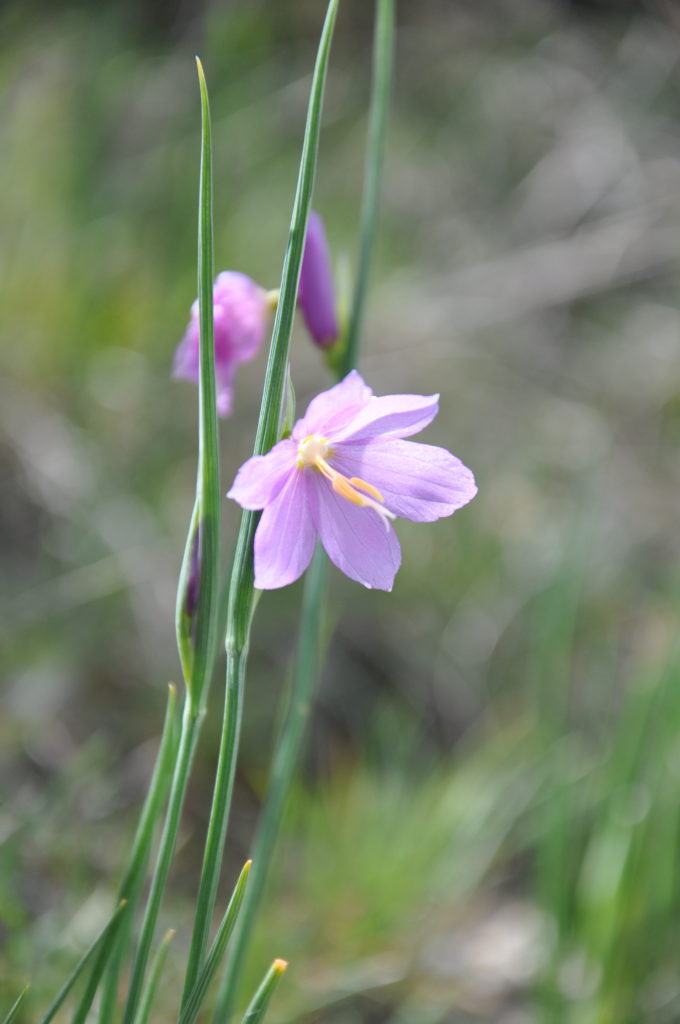
Viola beckwithii
Tucked under the skirts of sagebrush grows a tiny violet named in honor of Edward Griffin Beckwith, an officer in the United States Army who explored the west from 1853 to 1857, during the glory days of the Pacific Railroad Surveys. Beckwith‘s violet grows in five western states (California, Idaho, Nevada, Oregon, and Utah) which lie wholly or partially within the geographic boundaries of the Great Basin. The western honey bee (Apis mellifera), the most common of the world-wide honey bees, and the Ursine digger bee (Anthophora ursina) appear to be two of its primary pollinators. It flowers from March to May beneath shrubs or underneath pines in both dry and moist places. It is a member of the Violaceae (Violet family).
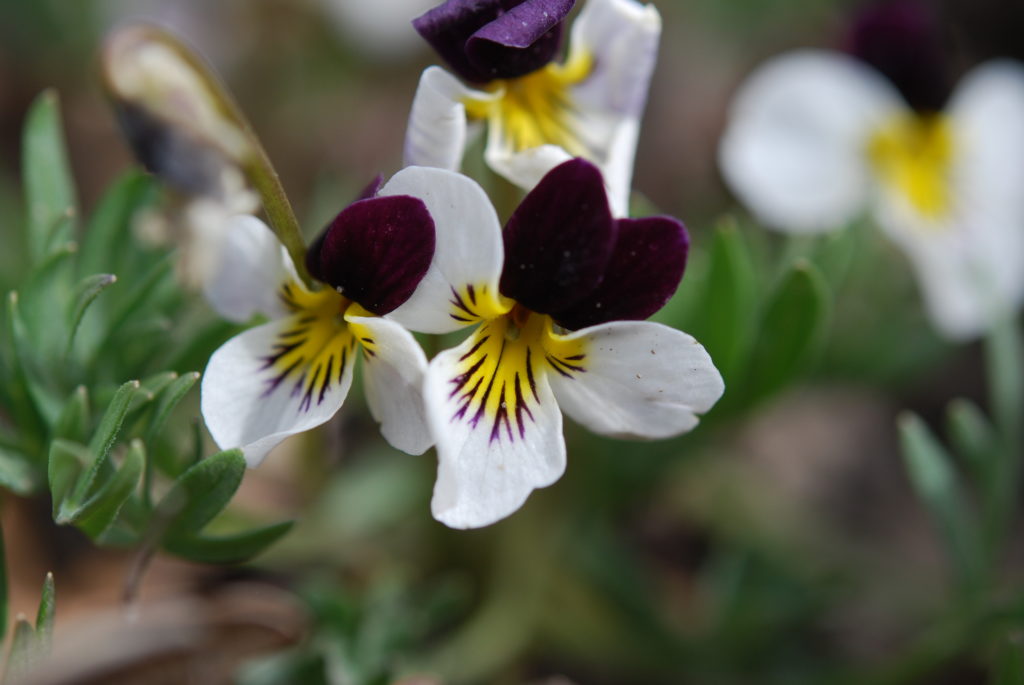
Orogenia linearifolia
Sereno Watson, joined the 1867 Clarence King Expedition, also known as the United States Geological Exploration of the Fortieth Parallel, and eventually became its expedition botanist. He named a specimen he collected in Utah in 1869, Orogenia, in his 1871 botanical report of the Fortieth Parallel Survey. Oros is Greek for mountain and genia alludes to the plant’s resemblance to the genus Erigenia, which is an eastern North America relative that grows in the rich soils of the hardwood forests of extreme southern Ontario, Canada, central New York and southern Wisconsin, and the western Ozarks to central Alabama. Orogenia linearifolia (Great Basin Indian potato) is part of the Apiaceae (Carrot family). It blooms in open meadows, often at mid-montane (3,000 to 9,000 ft.) elevations just after snow melt, often in extensive colonies. Within weeks the plant withers and is not detectable. Even when it is in full bloom one must look closely because it grows at most to four inches tall.
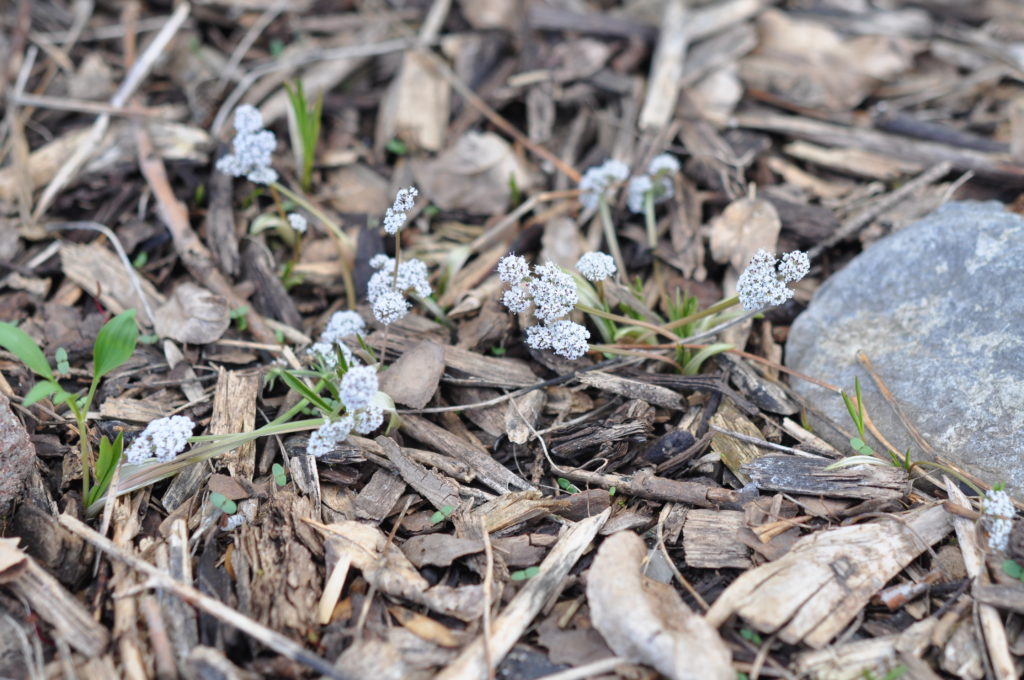
Selected Reading:
Wildflowers of the Pacific Northwest (A Timber Press Field Guide)
Wildflowers of the Mountain West
Wildflowers of the Rocky Mountain Region (A Timber Press Field Guide)
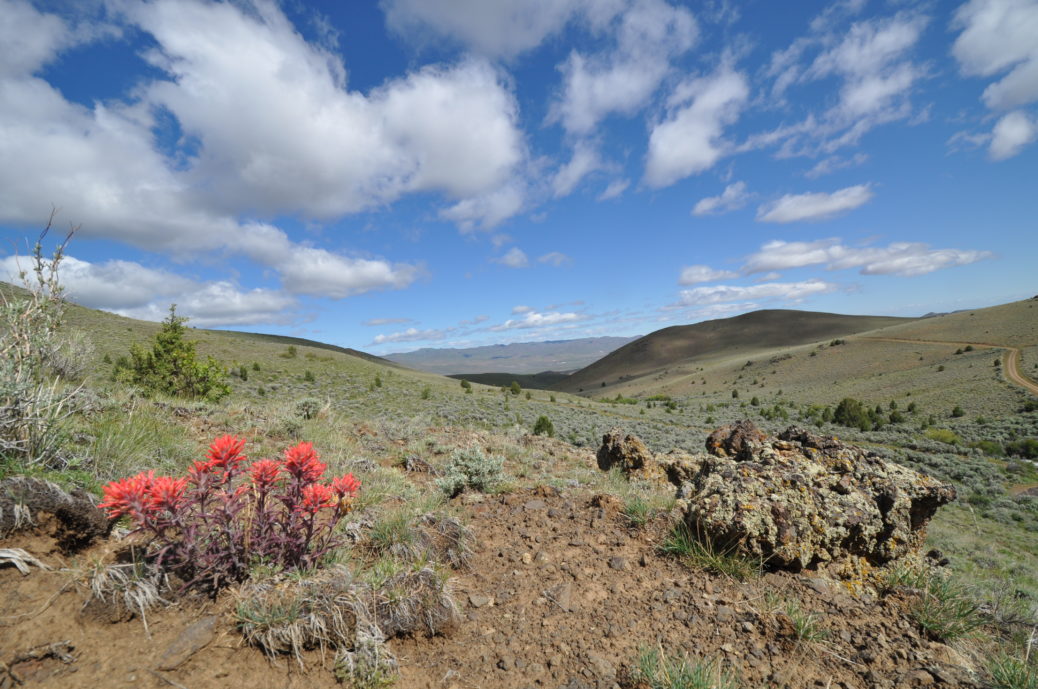
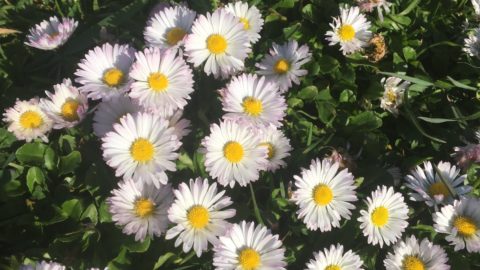
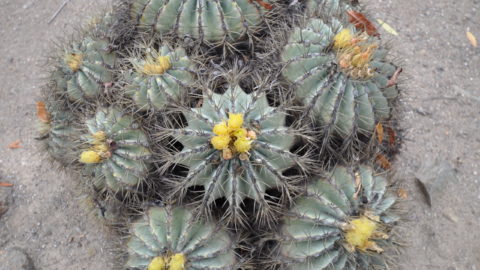
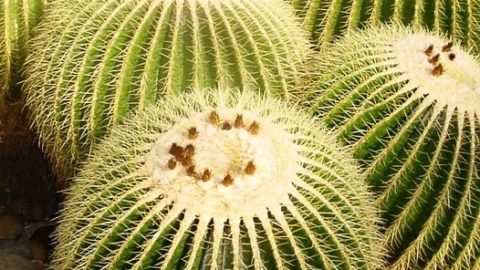
Awesome post! Keep up the great work! 🙂